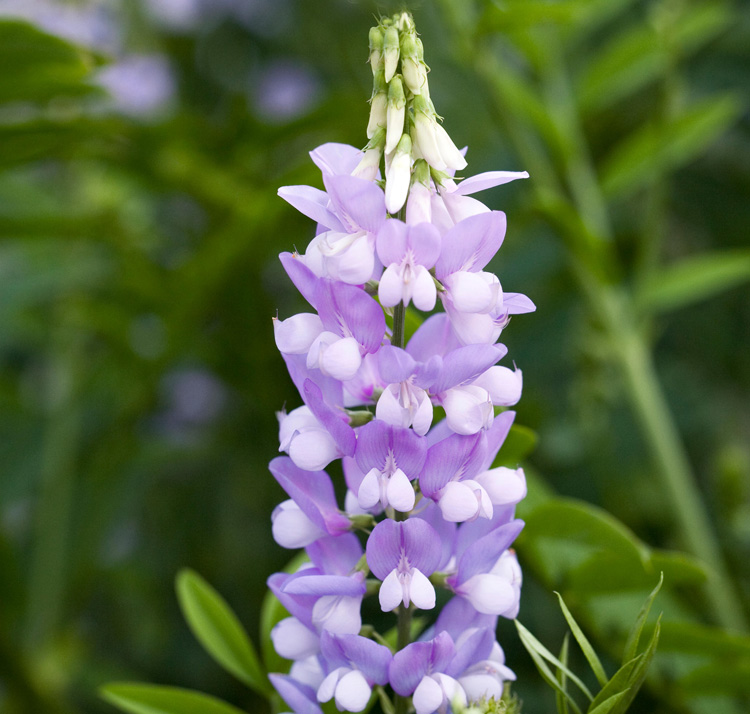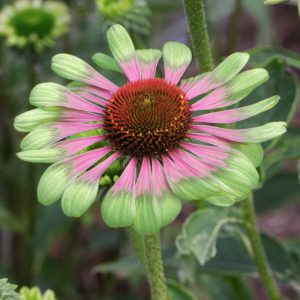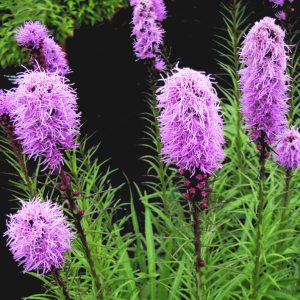- 1-9 pkts $4.50
- 10 pkts FREE
- Express post $12
Galega officinalis
GOAT’S RUE
Galega officinalis is a delightfully fine and delicate looking plant, in both flowers and foliage.
But in fact it is a tough and robust grower.
Spires of mini-Lupins & tiers of mini-Sweet Peas
The blooms of Galega officinalis are exquisite – resembling spires of mini-Lupins or perhaps tiers of mini-Sweet Peas.
In the prettiest shades from lilac-purple, through violet, to palest lilac-cream.
So another common name for Galega officinalis is French Lilac (and also Professor Plant!! and Holy Hay – see below).
This pretty plant continues to pop spires of blooms through summer and autumn.
Sweetly scented blooms
Blooms are sweetly perfumed without being cloying.
Finest ferny foliage
The foliage is also very fine, dainty and ferny.
Goat’s Rue is a mounding, scrambling sort of a plant, which will either mound across the ground as cover.
Or scramble lightly up into taller shrubs without smothering them, or over frames.
Tough and pretty enough to mix it with the natives
With its dainty, fine, ferny appearance – Galega officinalis blends well with Australian native plantings.
It is certainly also tough enough to mix it with the natives.
Shrugs off neglect, poor soil & heat
Goat’s Rue shrugs off neglect and can also thrive in poor soils, as it produces its own fertilizer and nitrogen, as well as sharing it with other nearby plants.
It is also well adapted to summer heat and winter frost, as a native of hot spots with stony poor soil in southern Europe and western Asia.
Tough Goat’s Rue will shrug off frost down to -20°C.
Really useful plant – for bees & pollinators
Bees and pollinators are drawn irresistibly to these nectar rich, sweetly scented flower spires.
For traditional medicinal herb
The name Galega derives from Greek – ‘gale’-meaning milk, and ‘ega’- “to bring on”.
Because traditional farmers used the herb to increase milk flow in lactating goats and sheep.
(Plus for a tea for newly birthed human mothers – though scientific research suggests it is too toxic for human mothers to take safely – not recommended).
What is certain is that cattle, goats and sheep love to eat it (but not too much at once is best).
For time-honoured cheese making
Goat’s Rue herb is also used in Europe and Britain to clot milk in time honoured cheese making techniques.
So it is sometimes also called “Cheese Rennet Herb”.
It was also used as a diuretic and treatment for diabetes in traditional village medicine (though again modern scientific research suggests possible negative side-effects in humans).
For forage crops & green manure
Plants of Galega officinalis are nitrogen fixers – so they add nitrogen to the soil from the nodules on their roots.
Making them a great green manure crop to grow on fallowing land and then turn into the soil to enrich.
Pretty scented flowers for a vase
Cut armloads of dainty flower spires and foliage for a vase.
Blooms are sweetly scented and both flowers and foliage last well, either fresh or dried.
Galega makes a fine filler, particularly inlooser more natural arrangements, and with native blooms.
Long lived and easy perennial
Galega officinalis is a long lived perennial plant – it will be with you for many years in a wide range of climates and positions.
Goat’s Rue prefers to be planted in part shade amongst trees and shrubs, but will also thrive in full sun with more moisture.
It is very heat and frost resistant, and is perfectly adapted to poor, low nutrient soils.
And will happily remain evergreen in mild positions, but be safely winter-deciduous in heavy frost areas.
Mounds 60-75cm. High x 90cm. Wide
SEED SOWING ADVICE:
Seed of Galega officinalis can be sown indoors at any time when suitable temperatures can be provided.
OR
Sown directly into the garden outdoors in autumn or spring.
Sow indoors for rapid & maximum germination: First boil some water, and allow to cool so you can put your finger in without burning, then pour over the seeds.
Allow the seeds to soak overnight (approx. 12 hours).
Then sow the seeds on the surface good quality seed raising mix.
And pat the seeds gently onto the surface of the mix to ensure good contact.
Now cover the seeds lightly with sieved mix, but do not bury deeply, as light aids germination.
Now soak the sown punnet in a shallow water bath, so the moisture percolates up from below through to the surface of the mix.
Then place in a warm, well lit place (not in any direct sunlight), or place on a heat mat.
Temperatures of 18-21 degrees C are best for rapid and optimum germination.
Continue to keep consistently moist by misting from a water-spray bottle.
And covering the punnet with a clear lid or plastic bag will also help to maintain consistent moisture.
Seeds germinate in 14 to 21 days approx.
However it is natural for Galega seed to stagger germination, to give seedlings a sporting chance to emerge into best conditions.
Some seeds will naturally be slower to germinate.
A cold chill improves germination rates
So a period of chilling immediately after sowing tends to increase and hasten germination rate.
Moisten the freshly sown punnet, wrap in cling wrap or a plastic bag, and place in the fridge (not freezer) for 2-4 weeks. This will hasten the speed and rate of germination, but is not essential.
After germination – prick seedlings out and pot on to harden off and mature, before planting out in the garden.
Seed Count: 15 seeds per pack approx.
(We always aim to exceed the seed count and give a generous serve)
Click here for Nursery Open Days & Open Gardens Information
https://www.gardivalia.com.au/open-gardens
Click here to go back to Seeds Shop
https://www.seedscape.net.au/shop/
Related products
-
Add to WishlistAlready In WishlistAdd to Wishlist
-
Add to WishlistAlready In WishlistAdd to Wishlist
-
Add to WishlistAlready In WishlistAdd to Wishlist
-
Add to WishlistAlready In WishlistAdd to Wishlist





